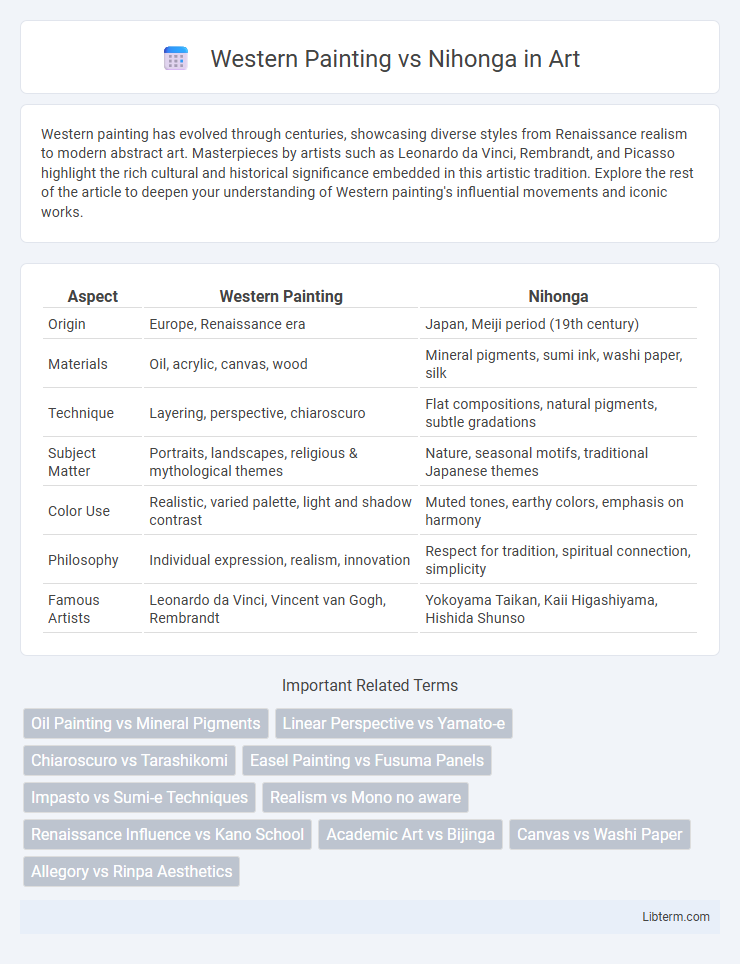Western painting has evolved through centuries, showcasing diverse styles from Renaissance realism to modern abstract art. Masterpieces by artists such as Leonardo da Vinci, Rembrandt, and Picasso highlight the rich cultural and historical significance embedded in this artistic tradition. Explore the rest of the article to deepen your understanding of Western painting's influential movements and iconic works.
Table of Comparison
| Aspect | Western Painting | Nihonga |
|---|---|---|
| Origin | Europe, Renaissance era | Japan, Meiji period (19th century) |
| Materials | Oil, acrylic, canvas, wood | Mineral pigments, sumi ink, washi paper, silk |
| Technique | Layering, perspective, chiaroscuro | Flat compositions, natural pigments, subtle gradations |
| Subject Matter | Portraits, landscapes, religious & mythological themes | Nature, seasonal motifs, traditional Japanese themes |
| Color Use | Realistic, varied palette, light and shadow contrast | Muted tones, earthy colors, emphasis on harmony |
| Philosophy | Individual expression, realism, innovation | Respect for tradition, spiritual connection, simplicity |
| Famous Artists | Leonardo da Vinci, Vincent van Gogh, Rembrandt | Yokoyama Taikan, Kaii Higashiyama, Hishida Shunso |
Introduction to Western Painting and Nihonga
Western painting encompasses a diverse range of styles and techniques developed from the Renaissance to modern art, characterized by realism, perspective, and the use of oil paints. Nihonga, a traditional Japanese painting style, employs natural pigments on washi paper or silk, emphasizing harmony with nature and cultural heritage. Both art forms reflect distinct philosophies and materials, shaping unique visual languages within global art history.
Historical Origins and Development
Western painting originated during the Renaissance in Europe, characterized by techniques such as linear perspective, chiaroscuro, and oil painting, evolving through movements like Baroque, Impressionism, and Modernism. Nihonga, rooted in traditional Japanese aesthetics, emerged in the late 19th century as a response to Western influence, emphasizing natural pigments, mineral-based colors, and subjects inspired by Japanese culture and nature. Both styles reflect distinct philosophical and cultural values, shaping their historical development and artistic identity.
Philosophical Foundations
Western painting emphasizes realism, perspective, and individual expression rooted in Renaissance humanism, highlighting the material world and the artist's subjective experience. Nihonga, influenced by Zen Buddhism and Shintoism, prioritizes harmony with nature, spiritual depth, and simplicity, reflecting an interconnectedness between humans and the natural world. These philosophical foundations shape each style's approach to form, technique, and thematic content, distinguishing the contemplative and meditative qualities of Nihonga from the analytical and observational focus of Western painting.
Materials and Techniques
Western painting predominantly uses oil paints, acrylics, and canvas, employing techniques such as layering, glazing, and impasto to create texture and depth. Nihonga, a traditional Japanese style, relies on natural pigments derived from minerals, shells, and plants, applied to washi paper or silk with sumi ink and nikawa glue, emphasizing delicate brushwork and subtle color gradations. The contrast between Western painting's synthetic mediums and Nihonga's organic materials highlights distinct cultural approaches to texture, durability, and visual expression in their respective art forms.
Subject Matter and Themes
Western painting often emphasizes realism, perspective, and diverse subject matters such as portraits, landscapes, and historical scenes, reflecting individualism and narrative depth. Nihonga, rooted in traditional Japanese aesthetics, focuses on themes from nature, seasonal changes, and classical literature, highlighting harmony and spirituality through stylized forms and natural pigments. The contrasting approaches reveal Western painting's exploration of human experience and Nihonga's connection to cultural symbolism and natural beauty.
Use of Color and Composition
Western painting emphasizes bold contrasts and dynamic compositions, often using chiaroscuro techniques to create depth and drama. Nihonga employs subtle color gradations derived from natural pigments, prioritizing harmony and asymmetry in composition to evoke tranquility and balance. The use of negative space in Nihonga contrasts with the Western focus on realism and detailed backgrounds, reflecting divergent aesthetic philosophies.
Symbolism and Iconography
Western painting often employs symbolism and iconography rooted in Christian themes, mythology, and Renaissance humanism, utilizing chiaroscuro and perspective to convey narrative depth and emotional intensity. Nihonga, a traditional Japanese painting style, emphasizes symbolic use of nature, seasonal motifs, and subtle color gradations to evoke spiritual harmony and cultural ideals, often reflecting Buddhist and Shinto influences. The contrast lies in Western art's focus on realistic representation and dramatic symbolism versus Nihonga's delicate abstraction and symbolic connection to nature and spirituality.
Evolution in Modern Art
Western painting evolved through movements such as Impressionism, Cubism, and Abstract Expressionism, emphasizing individual expression and experimental techniques. Nihonga, rooted in traditional Japanese methods and materials like mineral pigments on silk or paper, adapted by incorporating modern themes and blending with Western styles while preserving cultural identity. The evolution of both highlights a dynamic dialogue between innovation and heritage in modern art, reflecting globalization's impact on artistic practices.
Cultural Influences and Exchange
Western painting, rooted in techniques like oil and perspective developed during the Renaissance, profoundly influenced Nihonga through Japan's Meiji Restoration era cultural exchange. Nihonga preserves traditional Japanese aesthetics, using materials such as mineral pigments and washi paper, while selectively integrating Western realism and shading to create a hybrid visual language. This intercultural dialogue reflects broader historical shifts in Japan's modernization and Westernization, blending indigenous artistic values with global art movements.
Contemporary Perspectives and Future Trends
Western painting emphasizes individual expression and experimental techniques, often utilizing oil and acrylics with a focus on realism, abstraction, and conceptual art. Nihonga, rooted in traditional Japanese aesthetics, employs natural pigments and mineral-based materials on washi paper or silk, blending historical themes with modern reinterpretations to reflect evolving cultural identities. Emerging trends highlight a fusion of Western and Nihonga styles, integrating digital media and global art dialogues to redefine contemporary artistic boundaries.
Western Painting Infographic

 libterm.com
libterm.com